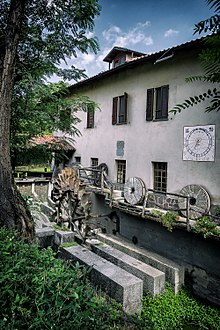
The watermills on the Olona River are buildings used for milling activities that are scattered along the banks of the Olona River in the Lombardy region of Italy.
They reached their peak of development in the 17th century with the presence along the banks of the river of about a hundred milling plants.[1] Thereafter, from the 18th to the 19th century, there was a phase of decline, which ended just after World War II, when there were only about ten active mills still present on the banks of the river.[1] As the centuries passed, their number gradually decreased, and only a small number have survived until the 21st century. Some of them are in a state of abandonment, while others have been recovered for a wide variety of purposes.
The presence of the mills, the abundance of local labor, the existence of modern and relevant communication routes along the banks, the presence of local personalities who had substantial capital to invest, and the long tradition of craftsmanship in the Olona Valley allowed the river, which flows through the province of Varese and Milan, to become one of the cradles of Italian industrialization.[2]
- ^ a b Macchione (1998, p. 120).
- ^ Macchione (1998, p. 131).